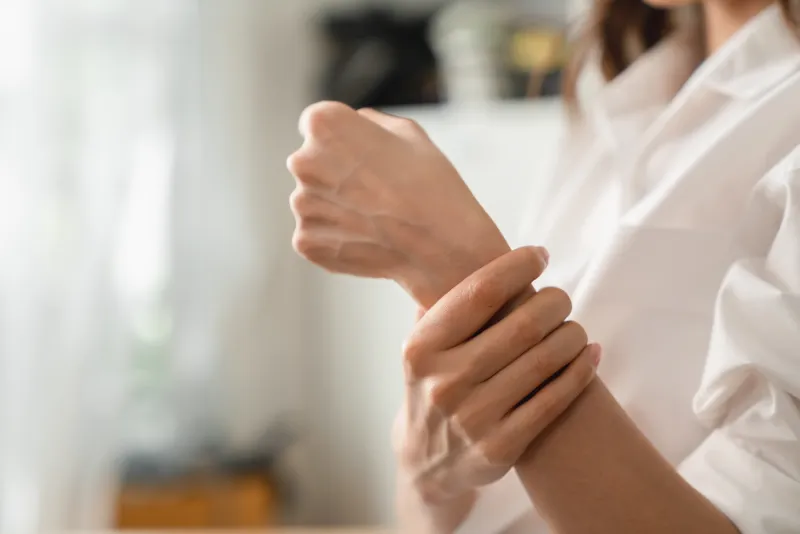Hypermobility Ehlers-Danlos Syndromes (hEDS)

Hypermobility Ehlers-Danlos Syndromes (hEDS)
Hypermobility Ehlers-Danlos syndromes (hEDS) represents one variant within the broader Ehlers-Danlos syndrome (EDS) classification. Historically known as EDS type III, hEDS is distinguished by generalised joint hypermobility, musculoskeletal manifestations, and certain skin features. Unlike other major types of EDS, the molecular defect causing hEDS remains unidentified (Tinkle et al., 2017).
Epidemiology
- A study involving 12,853 participants found that 3.4% demonstrated joint hypermobility and widespread pain, indicators suggesting potential hEDS (Mulvey et al., 2013).
- A twin study evidenced a genetic component: among dizygotic twins, the concordance rate for joint hypermobility stood at 36%. This rate increased to 60% among monozygotic twins (Hakim et al., 2004).
- The gender disparity is noticeable, with female-to-male ratios ranging from 9:1 to 2:1 (Castori et al., 2010). Chronic pain incidents are also higher among females, with hormonal fluctuations and psychological factors believed to play a role.
Clinical Presentation & Progression
Three progressive stages characterize hEDS:
- Hypermobility Phase: Symptoms include fatigue, lower limb pain, pain on fine motor control, and developmental delays such as dyspraxia. Individuals may experience isolated joint issues or more widespread musculoskeletal pain.
- Pain Phase: Ranging from the twenties to forties, this phase has shared characteristics with fibromyalgia and other chronic overlapping pain conditions. Common manifestations include gastrointestinal complaints, chronic fatigue, orthostatic intolerance, anxiety, sleep disturbances, and more (Tinkle et al., 2017).
- Stiffness Phase: This phase is marked by escalated pain and reduced joint mobility.
Skin & Fascial Manifestations
The skin is comparatively less elastic than in other EDS variants. Pelvic and abdominal diaphragm failures (Nelson et al., 2015) and hernias due to fascial weakness (Nazeem et al., 2013) are more frequent.
Neuropathic Involvement in hEDS
Neuropathic pain, often described subjectively, is common in hEDS. One study pinpointed small fiber neuropathy as a potential source (Cazzato et al., 2016). Genetic abnormalities in TNXB and collagens within nerve structures, combined with joint subluxations, might contribute to this (Voermans et al., 2009; Granata et al., 2013).
Diagnosis of hEDS
hEDS exhibits autosomal inheritance but with an unidentified molecular basis. For clinical diagnosis, the simultaneous presence of three criteria is essential:
- Generalized Joint Hypermobility (GJH): Determined through the Beighton score and adjusted by age and gender criteria. Additionally, the Five-Point Questionnaire, adapted from Grahame and Hakim (2003), aids in assessing GJH.
- Presence of Specific Features: At least two out of three features (A-C) need to be present, encompassing systemic manifestations of connective tissue disorders, a positive family history, and musculoskeletal complications.
- Essential Prerequisites: Absence of unusual skin fragility, exclusion of other heritable and acquired connective tissue disorders, and exclusion of alternative diagnoses.
Management
Due to their susceptibility to small nerve fibre neuropathy, hEDS patients are advised to be cautious about their consumption of fat, alcohol, sugar, and gluten. Limiting these foods can help prevent transient reactions. Anxiety, a well-acknowledged symptom, requires proper support structures. Tailored exercise programs have shown promise, with Swiss ball exercises, in particular, yielding favorable results for improving joint stability.
Testimonial
Thank you, Kieran, for helping me work out how to manage my hEDS and the pain that comes with it. Would struggle without your support. Still learning, but we’re getting there!
Success stories from our clients
EXCELLENT Lesley Becker
Lesley Becker